Computational Fluid Dynamics (CFD) has become an essential tool in various engineering fields. In aeronautics it is a key element in the design of modern aircrafts. The performances of today's computers combined with the increasing complexity of physical models yields numerical simulations that accurately reproduce the flow structures observed in practical experiments and permit to study their impact on flight stability. Yet, to fully exploit the huge amount of information contained in typical data sets engineers require powerful post-processing techniques that allow insight into the results of their large-scale computation.
Flow visualization aims at addressing this challenge by offering intuitive and effective depictions of interesting flow patterns. Unfortunately, many problems remain that limit the usefulness of existing methods in practical applications. Our recent work has focused on the design of new visualization techniques suitable for large-scale CFD simulations. Special emphasis was put on critical flight situations that lead to turbulent and vortical flows as well as complex and structurally involved phenomena like flow recirculation and vortex breakdown.
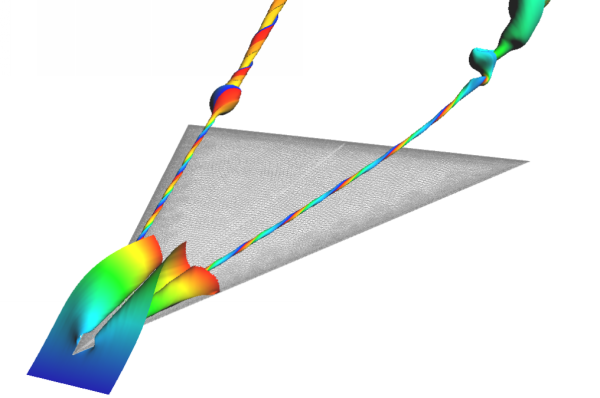 Fig. 1 |
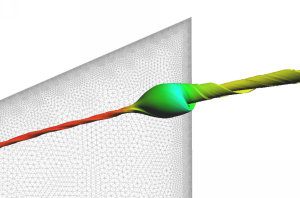 Fig. 2 |
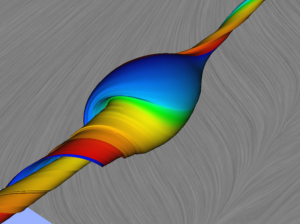 Fig. 3 |
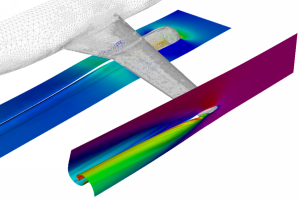 Fig. 4 |
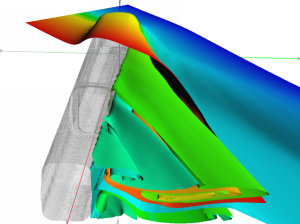 Fig. 5 |
Recirculation bubbles are prominent examples of such features. They characterize the vortex breakdown phenomenon that has a dramatic impact on the flight stability of high-performance aircrafts like delta wings flying at low speed and high angle of attack. Such configurations typically occur during takeoff and landing. Therefore vortex breakdown is a critical issue that stands in the way of an industrial implementation of these high-speed designs. Nowadays, CFD computations allow for numerical analysis and investigation of the patterns present in flows undergoing vortex breakdown. However, the extreme structural intricacy of these features is poorly visualized using standard approaches. Vortex core extraction schemes are typically unable to extract the skeleton of the associated swirling motion. Stream surfaces are more robust and provide a general idea of the overall shape of the bubble but they also lead to cluttered pictures inside the bubble and do not permit a precise analysis of the flow behavior in the recirculation region.
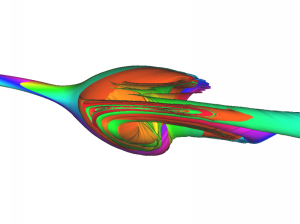 Fig. 6 Fig. 6 |
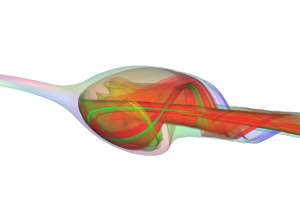 Fig. 7 Fig. 7 |
 Fig. 8 |
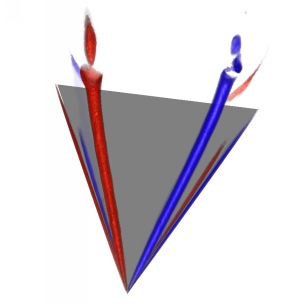 Fig. 9 |
|
 Fig. 10 Fig. 10 |
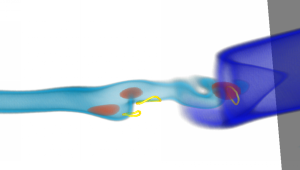 Fig. 11 Fig. 11 |
 Fig. 12 Fig. 12 |
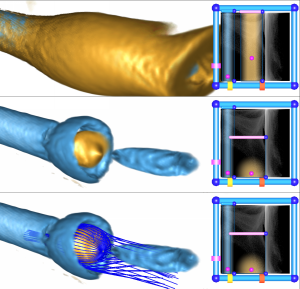 Fig. 13 |
See publications:
C. Garth, X. Tricoche, T. Salzbrunn, T. Bobach, G. Scheuermann. "Surface Techniques for Vortex Visualization," Proceedings of Joint EUROGRAPHICS - IEEE TCVG Symposium on Visualization (VisSym '04), Constance, Germany, 2004.Versions Available: [PDF]
X. Tricoche, C. Garth, T. Bobach, G. Scheuermann, M. Ruetten. "Accurate and Efficient Visualization of Flow Structures in a Delta Wing Simulation," In Proceedings of 34th AIAA Fluid Dynamics Conference and Exhibit, Portland, OR., June, 2004.
Xavier Tricoche, Christoph Garth, Gordon Kindlmann, Eduard Deines, Gerik Scheuermann, Markus Rütten, Charles Hansen. "Visualization of Intricate Flow Structures for Vortex Breakdown Analysis," In Proceedings of IEEE Visualization 2004, pp. (accepted). 2004.Versions Available: [PDF]
Principal Researchers
- Dr. Xavier Tricoche
- Christoph Garth
